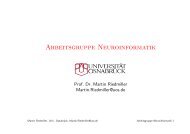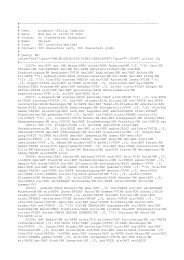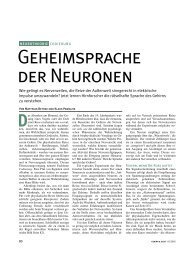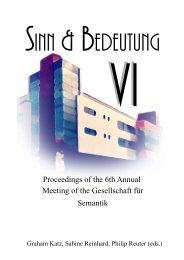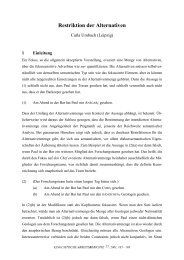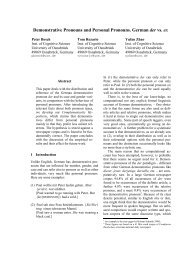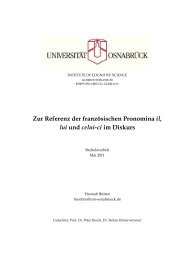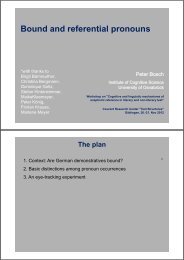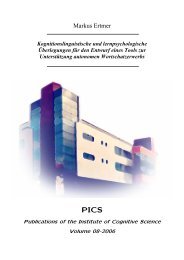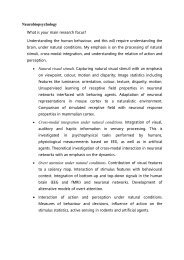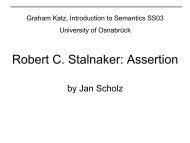Two systems of anaphorically used pronouns in plain text and in ...
Two systems of anaphorically used pronouns in plain text and in ...
Two systems of anaphorically used pronouns in plain text and in ...
You also want an ePaper? Increase the reach of your titles
YUMPU automatically turns print PDFs into web optimized ePapers that Google loves.
29. DGfS-Jahrestagung, Siegen, 28.2.-2.3.2007 AG 13 Anaphoric uses <strong>of</strong> demonstrative expressions<br />
Klaus Geyer, Vilnius<br />
klaus_geyer@gmx.net<br />
<strong>Two</strong> <strong>systems</strong> <strong>of</strong> <strong>anaphorically</strong> <strong>used</strong> <strong>pronouns</strong> <strong>in</strong> pla<strong>in</strong> <strong>text</strong> <strong>and</strong> <strong>in</strong> reported speech:<br />
der/die <strong>and</strong> its counterparts <strong>in</strong> spoken German<br />
1 Scope <strong>and</strong> aim <strong>of</strong> the study<br />
2 Corpus description<br />
3 Anaphorically <strong>used</strong> <strong>pronouns</strong> <strong>in</strong> pla<strong>in</strong> <strong>text</strong><br />
4 Anaphorically <strong>used</strong> <strong>pronouns</strong> <strong>in</strong> reported speech<br />
5 Conclusions<br />
6 References<br />
1 Scope <strong>and</strong> aim <strong>of</strong> the study<br />
• der/die (traditionally seen as a demonstrative) vs. er/sie (anaphoric) vs. clitic <strong>pronouns</strong>,<br />
form<strong>in</strong>g a threefold dist<strong>in</strong>ction <strong>of</strong> anaphoric (or: <strong>anaphorically</strong> <strong>used</strong>) <strong>pronouns</strong> <strong>in</strong><br />
spoken German;<br />
• corpus-based study (narrative <strong>text</strong>s);<br />
• <strong>pronouns</strong> are organised <strong>in</strong> 2 different <strong>systems</strong> <strong>in</strong> pla<strong>in</strong> <strong>text</strong> vs. <strong>in</strong> reported speech<br />
sequences;<br />
• which role do the ma<strong>in</strong> pronoun functions <strong>of</strong> track<strong>in</strong>g referents <strong>and</strong> <strong>of</strong> structur<strong>in</strong>g<br />
<strong>in</strong>formation play with<strong>in</strong> these 2 <strong>systems</strong>?<br />
2 Corpus description<br />
• spontaneous spoken German, predom<strong>in</strong>antly narrative <strong>text</strong>s; East Franconian dialect as<br />
spoken <strong>in</strong> the village <strong>of</strong> Hetzles (1200 residents, Northern Bavaria) – but not a<br />
Bavarian dialect;<br />
• <strong>in</strong>formants from two generations: ~ 30 years <strong>and</strong> ~ 60-70 years. Both men <strong>and</strong> women,<br />
at least 1 person for each <strong>of</strong> the possible comb<strong>in</strong>ations <strong>in</strong>cluded; total 7 <strong>in</strong>formants,<br />
amount <strong>of</strong> <strong>text</strong> roughly equally distributed among generations <strong>and</strong> sexes.<br />
• record<strong>in</strong>gs made <strong>in</strong> 1999, monolog <strong>and</strong> dialog <strong>text</strong>s, ~ 40 m<strong>in</strong> (out <strong>of</strong> 5,5 h) selected,<br />
~ 1100 pause units ~ 10.000 runn<strong>in</strong>g words;<br />
• small corpus, but <strong>pronouns</strong> as extremely frequently occurr<strong>in</strong>g elements! Text data completed/exp<strong>and</strong>ed<br />
by cautious elicitation data (e.g. to obta<strong>in</strong> negative evidence).<br />
3 Anaphorically <strong>used</strong> <strong>pronouns</strong> <strong>in</strong> pla<strong>in</strong> <strong>text</strong>s<br />
3 types <strong>of</strong> <strong>anaphorically</strong> <strong>used</strong> <strong>pronouns</strong> <strong>in</strong> the phoric system <strong>in</strong> pla<strong>in</strong> <strong>text</strong>/discourse:<br />
d-<strong>pronouns</strong> (der/die), k-<strong>pronouns</strong> (simple clitics, < er/sie), <strong>and</strong> s-<strong>pronouns</strong> (er/sie).<br />
1
3.1 Quantitative f<strong>in</strong>d<strong>in</strong>gs<br />
somewhat surpris<strong>in</strong>g frequency figures (only <strong>pronouns</strong> referr<strong>in</strong>g to entities, not to clauses<br />
or propositions; generally no neuter forms counted):<br />
(1)<br />
188 d-<strong>pronouns</strong><br />
190 k-<strong>pronouns</strong><br />
25 s-<strong>pronouns</strong><br />
→ it is the s-pronoun that is the marked member <strong>and</strong> that needs a particular explanation!<br />
3.2 Qualitative analysis<br />
d-<strong>pronouns</strong>, typical example (Geyer 2003, ex. 1-69, transcription simplified)<br />
(2) ... is a glans maadlë dabai gveesn dii is nauf und nundëgl<strong>of</strong>m<br />
‘... ist e<strong>in</strong> kle<strong>in</strong>es Mädchen dabei gewesen, die ist h<strong>in</strong>auf- und h<strong>in</strong>untergelaufen’<br />
‘... a little girl took part, she ran up <strong>and</strong> down’<br />
k-<strong>pronouns</strong>, typical example (Geyer 2003, ex. 7-53ff, transcription simplified)<br />
(3) no håd=s doch dsvaa nefm und dii håm=s/ imë gsåchd jaa unë feënseedaame vii=s<br />
nåchë haamghumë sen håm=si=s abl rechd dsum naën ghaldn<br />
‘da hat sie doch zwei Neffen und die haben sie/ immer gesagt ja unsere Fernseh<br />
dame als sie dann nach Hause gekommen s<strong>in</strong>d haben sie sie immer recht zum<br />
Narren gehalten’<br />
‘so she’s got two nephews <strong>and</strong> they called her/ <strong>used</strong> to say oh our TV-lady when<br />
they came home then, they always made a fool <strong>of</strong> her’<br />
cf. also (4) (Geyer 2003, ex. 2-1ff, transcription simplified)<br />
(4) also guud dåå våë a mõõ und deë håd biën grisn und also deë våë seë schdolds<br />
auf sai biën und dan håd=ë an ghoëb ...<br />
‘also gut da war e<strong>in</strong> Mann und der hat Birnen gerissen (‘gepflückt’) und also der<br />
war sehr stolz auf se<strong>in</strong>e Birnen und dann hat er e<strong>in</strong>en Korb...’<br />
‘well, there was a man <strong>and</strong> he was pick<strong>in</strong>g pears <strong>and</strong> well he was very proud<br />
<strong>of</strong> his pears <strong>and</strong> then he [had] a basket…’<br />
Ma<strong>in</strong> difference <strong>in</strong> the <strong>in</strong>formation structural value <strong>of</strong> the respective referents:<br />
cf. Lambrecht 1994: 109 (“identifiable” branch only):<br />
(5)<br />
identifiable<br />
<strong>in</strong>active accessible active<br />
<strong>text</strong>ually situationally <strong>in</strong>ferentially<br />
2
Lambrecht 1994: 163:<br />
„In select<strong>in</strong>g a topic for a sentence, a speaker makes a communicative decision as to the<br />
‘po<strong>in</strong>t <strong>of</strong> departure’ for the new <strong>in</strong>formation, i.e. as to the entity that she wishes to convey<br />
<strong>in</strong>formation about. But before mak<strong>in</strong>g this communicative decision, the speaker must<br />
make certa<strong>in</strong> hypotheses concern<strong>in</strong>g the status <strong>of</strong> the referent <strong>of</strong> the topic <strong>in</strong> the m<strong>in</strong>d <strong>of</strong><br />
the addressee at the time <strong>of</strong> the utterance. On the basis <strong>of</strong> these hypotheses, the speaker<br />
then decides upon the form <strong>of</strong> the sentence <strong>in</strong> which the topic is to be coded. However, the<br />
fact that a particular referent has the activation properties required for topic function <strong>in</strong> a<br />
sentence does not entail that it must be coded as topic.“<br />
• Function <strong>of</strong> the d-pronoun: establish<strong>in</strong>g already active referents as new topics.<br />
• Function <strong>of</strong> the k-pronoun: cont<strong>in</strong>u<strong>in</strong>g already topical (<strong>and</strong> active) referents as topics.<br />
The Topic Acceptability Scale (cf. Lambrecht 1994: 165)<br />
(6)<br />
activation state<br />
acceptability as topic<br />
active<br />
maximal<br />
accessible<br />
↑<br />
<strong>in</strong>active<br />
↓<br />
...<br />
(not identifiable)<br />
(m<strong>in</strong>imal)<br />
Preferred topic expression<br />
(7)<br />
Zero Clitic/bound Pronoun Pronoun Def<strong>in</strong>ite NP Indef<strong>in</strong>ite NP<br />
pronoun [-stress] [+stress]<br />
–––––––––––––––––––––––––––––––––––––––––––––––––→<br />
Markedness <strong>of</strong> occurrence as topic (Van Val<strong>in</strong> / LaPolla 1997: 205)<br />
• s-pronoun, as an allomorph <strong>of</strong> the k-pronoun, is be<strong>in</strong>g <strong>used</strong> if the host for the clitic<br />
pronoun is lack<strong>in</strong>g (e.g. utterance-<strong>in</strong>itial or after a pause)<br />
Examples: (Geyer 2003, ex. 1-7f, transcription simplified)<br />
(8) guud dii is efangeelisch abë sii voond ja eds scho a dsaidlang <strong>in</strong> hedsles<br />
‘gut die ist evangelisch aber sie wohnt ja jetzt schon e<strong>in</strong>e Zeitlang <strong>in</strong> Hetzles’<br />
‘well she is Lutheran but now she has been liv<strong>in</strong>g <strong>in</strong> Hetzles for a time’<br />
word order changed (by elicitation):<br />
(9) ... abë eds voond=s ja scho a dsaidlang <strong>in</strong> hedsles<br />
‘... aber jetzt wohnt sie ja schon e<strong>in</strong>e Zeitlang <strong>in</strong> Hetzles’<br />
‘...but now she has been liv<strong>in</strong>g <strong>in</strong> Hetzles for a time’<br />
3
3.3 Related notions<br />
• We<strong>in</strong>rich 1993: thematicity (s-pronoun) vs. rhematicity (d-pronoun); d-pronoun is<br />
rarely <strong>used</strong> (!), <strong>in</strong> order to keep the d-<strong>pronouns</strong>’ function as “Aufmerksamkeitssignal”<br />
‘signal <strong>of</strong> attention’<br />
• Delisle 1993: d-<strong>pronouns</strong> is characterised by the notion <strong>of</strong> contrast<br />
• Zifonun / H<strong>of</strong>fmann / Strecker 1997: d-<strong>pronouns</strong> for re-orient<strong>in</strong>g the hearer, s-<strong>pronouns</strong><br />
for ma<strong>in</strong>ta<strong>in</strong><strong>in</strong>g the hearer’s orientation; based on Ehlich’s concept <strong>of</strong> deictic procedure<br />
vs. (ana)phoric procedure: „The anaphoric procedure is a l<strong>in</strong>guistic means to make the<br />
hearer susta<strong>in</strong> a previously established focus towards a specific item. The deictic<br />
procedure is a l<strong>in</strong>guistic means to achieve the focus<strong>in</strong>g <strong>of</strong> the hearer’s attention towards<br />
a specific item.“ (Ehlich 1979)<br />
• Behaghel 1923: “ruhige Weiterführung” ‘calm cont<strong>in</strong>uation’ for s-<strong>pronouns</strong>, “gewisse<br />
Spannung” ‘certa<strong>in</strong> tension’ for d-<strong>pronouns</strong><br />
• similar f<strong>in</strong>d<strong>in</strong>gs (pla<strong>in</strong> discourse) for Dutch by Comrie 1997?<br />
4 Anaphorically <strong>used</strong> <strong>pronouns</strong> <strong>in</strong> reported speech<br />
• d-<strong>pronouns</strong> force an <strong>in</strong>terpretation <strong>of</strong> disjo<strong>in</strong>t reference <strong>of</strong> report<strong>in</strong>g <strong>and</strong> reported<br />
speaker (more ‘basic’ pronom<strong>in</strong>al function than <strong>in</strong> pla<strong>in</strong> <strong>text</strong>).<br />
• k-<strong>pronouns</strong> allow both a coreferential <strong>in</strong>terpretation <strong>of</strong> report<strong>in</strong>g <strong>and</strong> reported speaker<br />
as well as disjo<strong>in</strong>t reference.<br />
• s-<strong>pronouns</strong> <strong>in</strong>dicate coreference <strong>of</strong> report<strong>in</strong>g <strong>and</strong> reported speaker (logophoric?<br />
somewhat unclear data...)<br />
cf. (10) – (12), based on Geyer 2003, ex. 1-50, modified by elicitation:<br />
(10) (und dan håd=ë i gsåchd) naa und des måchd=ë i/j ned<br />
‘und dann hat er i gesagt ne<strong>in</strong> und das macht er i/j nicht’<br />
‘<strong>and</strong> then he i said no, he i/j would’t do that’<br />
(11) und dan håd=ë i gsåchd naa und des måchd deë *i/j ned<br />
‘und dann hat er i gesagt ne<strong>in</strong> und das macht der *i/j nicht’<br />
‘<strong>and</strong> then he i said no, he *i/j would’t do that’<br />
(12) und dan håd=ë i gsåchd des måchd eë i/*j ned<br />
‘und dann hat er i gesagt das macht er i/*j nicht’<br />
‘<strong>and</strong> then he i said no, he i/*j would’t do that’<br />
4
5 Conclusions<br />
• 3 <strong>pronouns</strong> <strong>in</strong> spoken German: d-, k-, <strong>and</strong> s-<strong>pronouns</strong>, the latter be<strong>in</strong>g <strong>used</strong> only under<br />
certa<strong>in</strong>, restricted conditions;<br />
• 2 different <strong>systems</strong> <strong>in</strong> pla<strong>in</strong> discourse <strong>and</strong> <strong>in</strong> reported discourse;<br />
• discern<strong>in</strong>g <strong>in</strong>formation structure differences as ma<strong>in</strong> function <strong>in</strong> pla<strong>in</strong> discourse:<br />
establish<strong>in</strong>g active referents as new topics (d-<strong>pronouns</strong>) vs. cont<strong>in</strong>u<strong>in</strong>g already<br />
established topics (k-<strong>pronouns</strong>) (<strong>in</strong> narrative <strong>text</strong> with a dynamic structure);<br />
• discern<strong>in</strong>g reference <strong>in</strong> reported discourse: d-<strong>pronouns</strong> for different-speaker read<strong>in</strong>g, s-<br />
<strong>pronouns</strong> for same-speaker read<strong>in</strong>g, k-<strong>pronouns</strong> for both <strong>of</strong> them.<br />
Open question: Is the d-pronoun a true demonstrative at all? It does not take part <strong>in</strong> the<br />
dist<strong>in</strong>ction proximal – remote, the core characteristic <strong>of</strong> demonstratives (cf. Diessel 1999,<br />
Bhat 2004 <strong>and</strong> others). How valid is the historical argument, d-<strong>pronouns</strong> be<strong>in</strong>g historically<br />
derived from an I-E. demonstrative *to (cf. e.g. Szemerény 1990)?<br />
6 References<br />
Behaghel, Otto. 1923. Deutsche Syntax: e<strong>in</strong>e geschichtliche Darstellung. Vol. 1: Die<br />
Wortklassen und Wortformen. A Nomen. Pronomen. Heidelberg: W<strong>in</strong>ter.<br />
Bhat, Darbhe Narayana Shankara. 2004. Pronouns. Oxford etc: Oxford University Press.<br />
Comrie, Bernard. 1997. “Pragmatic b<strong>in</strong>d<strong>in</strong>g: demonstratives as anaphora <strong>in</strong> Dutch”,<br />
Proceed<strong>in</strong>gs <strong>of</strong> the Annual Meet<strong>in</strong>g <strong>of</strong> the Berkeley L<strong>in</strong>guistic Society 23, pp 49-61.<br />
Delisle, Helga. 1993. “Anaphora <strong>in</strong> German discourse: an empirical study”, Eid, Mushira /<br />
Iverson, Gregory (eds.): Pr<strong>in</strong>ciples <strong>and</strong> prediction: the analysis <strong>of</strong> natural language.<br />
Amsterdam, Philadelphia: Benjam<strong>in</strong>s. pp 243-268.<br />
Diessel, Holger. 1999. Demonstratives: form, functions, <strong>and</strong> grammaticalization.<br />
Amsterdam, Philadelphia: Benjam<strong>in</strong>s. (= Typological Studies <strong>in</strong> Language; 42)<br />
Ehlich, Konrad. 1979. Verwendung der Deixis beim sprachlichen H<strong>and</strong>eln: l<strong>in</strong>guistischphilologische<br />
Untersuchungen zum hebräischen deiktischen System. 2 Vols.<br />
Frankfurt: Lang.<br />
Geyer, Klaus. 2003. Hetzlerisch: Dokumentation spontansprachlicher Texte und<br />
grammatische Analyse der phorischen Pronom<strong>in</strong>a im ostfränkischen Dialekt des<br />
Dorfes Hetzles. München: L<strong>in</strong>com Europa. (= Studies <strong>in</strong> Germanic L<strong>in</strong>guistics; 21)<br />
Lambrecht, Knud. 1994. Information structure <strong>and</strong> sentence form: topic, focus <strong>and</strong> the<br />
mental representation <strong>of</strong> discourse referents. Cambridge etc.: Cambridge University<br />
Press. (= Cambridge Studies <strong>in</strong> L<strong>in</strong>guistics; 71)<br />
Szemerény, Oswald. 1990. E<strong>in</strong>führung <strong>in</strong> die vergleichende Sprachwissenschaft. 4. ed.<br />
Darmstadt: Wissenschaftliche Buchgesellschaft.<br />
Van Val<strong>in</strong>, Robert D. / LaPolla, R<strong>and</strong>y J. 1997. Syntax. Cambridge: Cambridge<br />
Universitiy Press.<br />
We<strong>in</strong>rich, Harald. 1993. Textgrammatik der deutschen Sprache. Mannheim etc.:<br />
Dudenverlag.<br />
Zifonun, Gisela / H<strong>of</strong>fmann, Ludger / Strecker, Bruno et al. 1997. Grammatik der<br />
deutschen Sprache. 3 Vols. Berl<strong>in</strong> etc.: de Gruyter. (= Schriften des Instituts für<br />
Deutsche Sprache; 7,1-7,3)<br />
5



